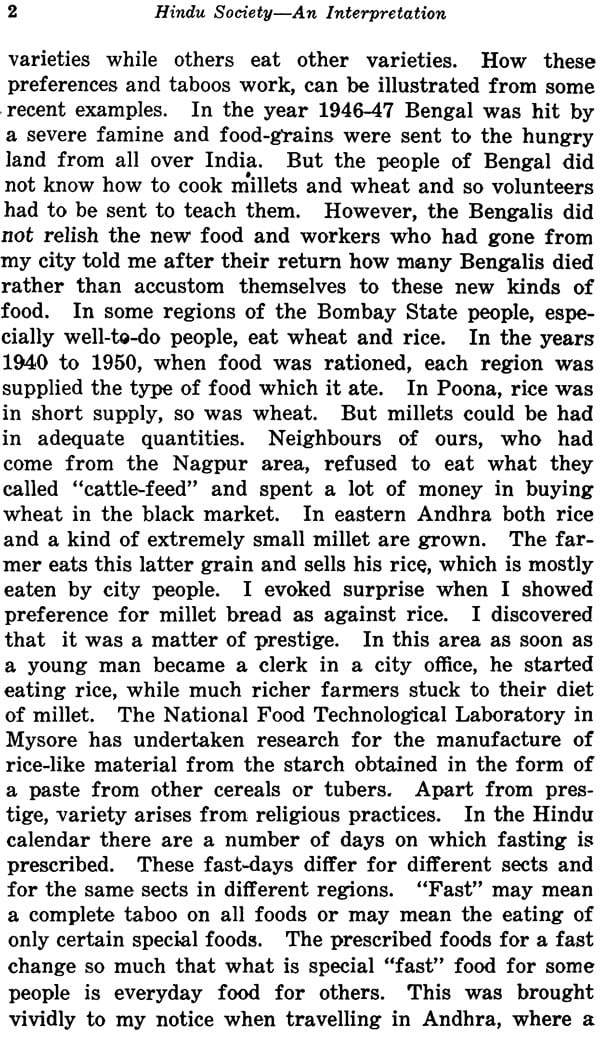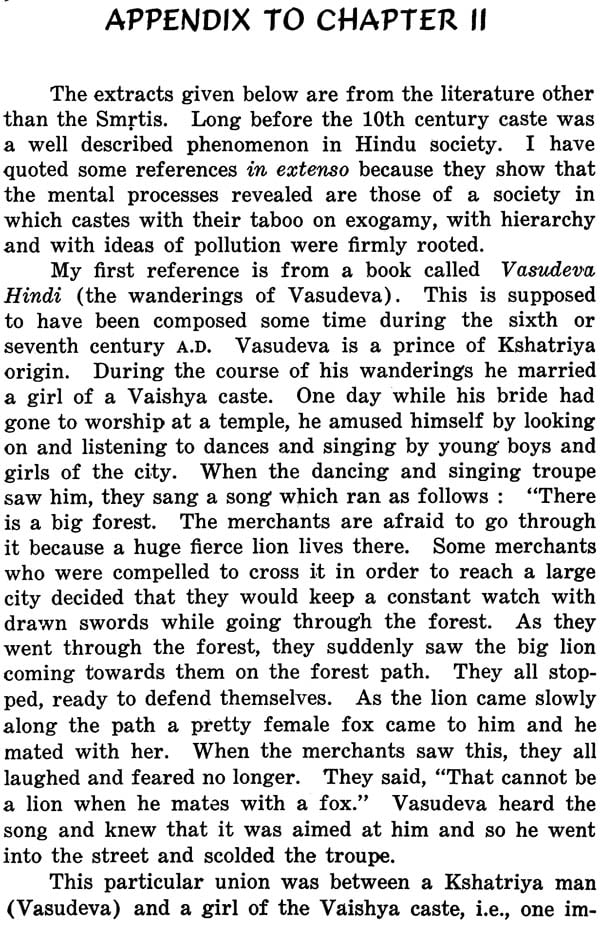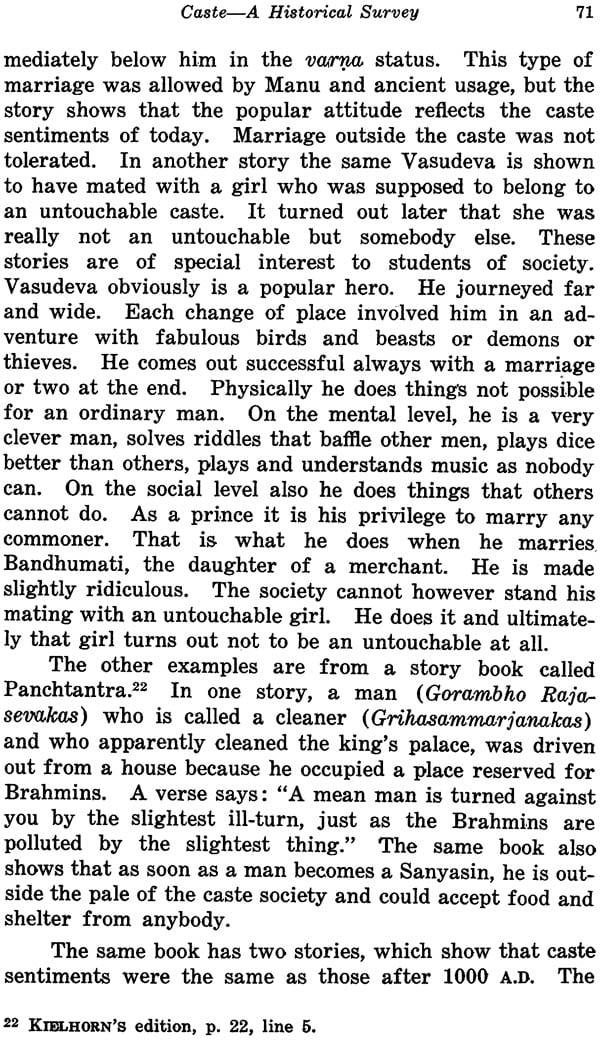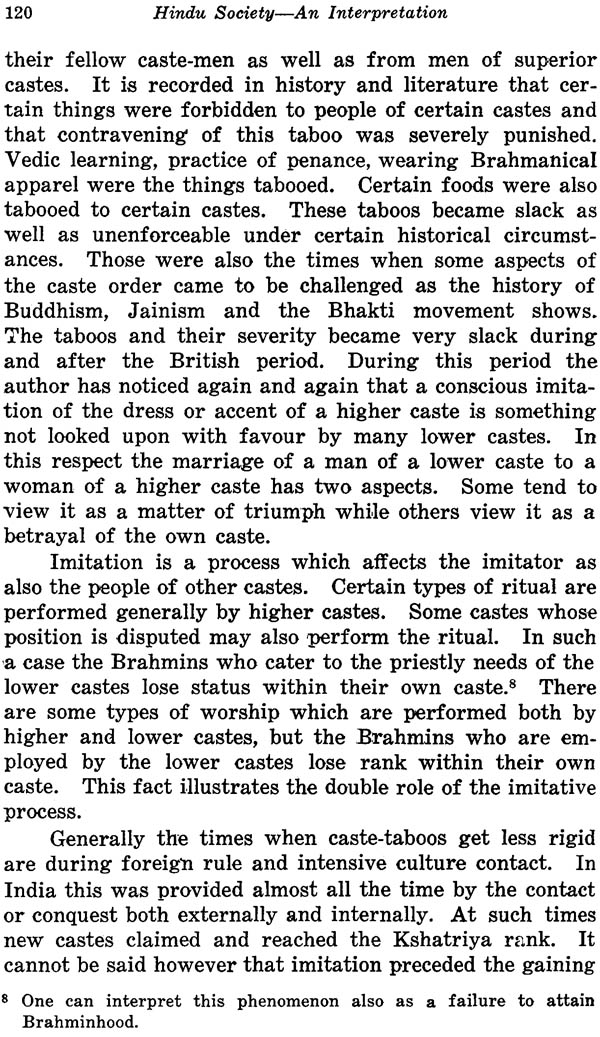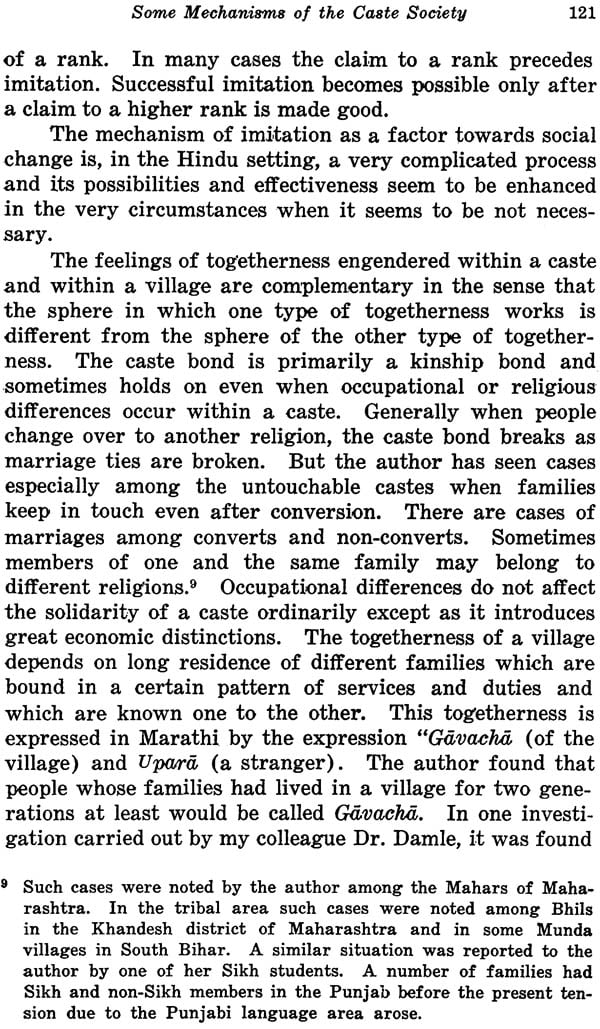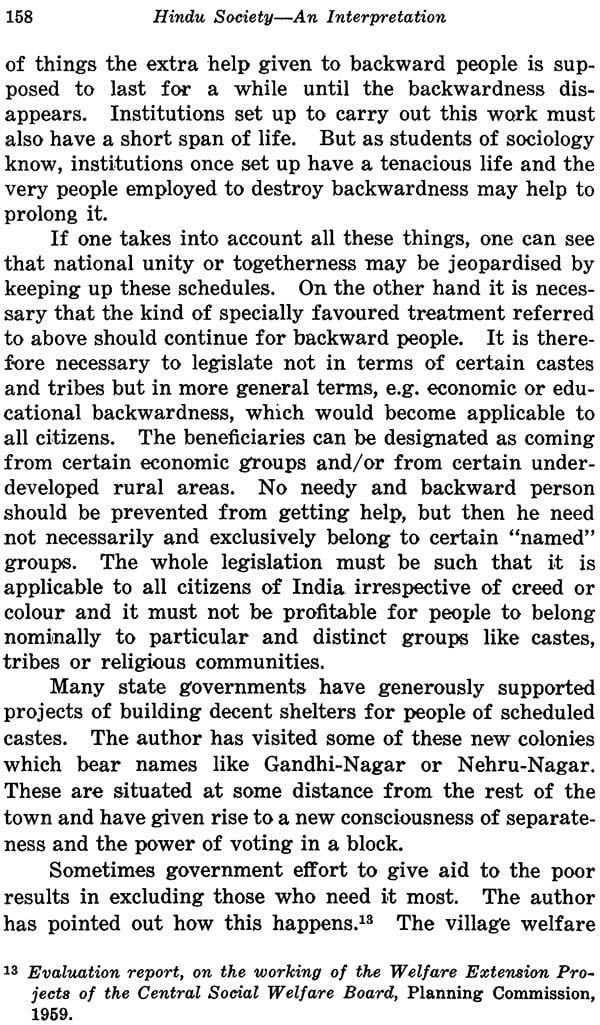
Hindu Society- An Interpretation
Book Specification
| Item Code: | NAM069 |
| Author: | Irawati Karve |
| Publisher: | -1 |
| Language: | English |
| Edition: | 1961 |
| Pages: | 184 |
| Cover: | Paperback |
| Other Details | 8.5 inch x 5.5 inch |
| Weight | 240 gm |
Book Description
This book is the result of my deliberations on the data collected by me in the course of my field work in different parts of India during the last twenty years and of my perusal of the literature in Sanskrit, Prakrit and the modern Indian languages. Four articles entitled “What is Caste” published in the Economic Weekly of Bombay during 1958-59 presented some of my ideas in a very condensed form. They were further elaborated in a series of lectures which I gave before the South Asia Colloquium of the University of California at Berkeley in 1959-60. I am deeply indebted to many colleagues in India and the U. S. A., too numerous to be mentioned by name, for their criticism, suggestions and encouragement after reading the first draft. I must however mention the name of one who I was sure would have read this book and offered helpful comments as he did after he read my book on Kinship ––I mean the late Professor Clyde Kluckhohn.
In this book Dr. IRAWATI KARVE sums up her lifetime work of investigating the structure and history of Indian society and in so doing she presents a series of important theories and conclusions which all person interested in that subject need to consider with great attention. Her thoughts are based upon two main sources of information––extensive field research in many parts of India, but especially in her home land Maharashtra, and a study of pertinent material in Sanskrit and allied literature from the time of the Rig Veda. Associated with this has been copious reading in other scholars’ work and weighing of others’ social theories. Few investigators have had such excellent equipment for this kind of study and can present material which is so informative and suggestive.
Most of her attention is naturally given to the caste system. She opens with a chapter on the variety of behavioural patterns in Indian society, a phenomenon which is so extreme that it would be hard to explain by the traditional Hindu teaching that the proliferation of castes is the result of fission, sub-fission, sub- sub-fission, and so on, of a limited number of “original” castes––four or five––differentiated by occupation or function. That improbable view is rendered untenable on the basis of a number of considerations including her own study of blood types and other physical characteristics. From such studies and other considerations she finds it possible to define scientifically, rather than impressionistically, a typical caste (jati) as an extended family, a kinship entity, hence endogamous, normally with a hereditary occupation. The inclusion of the caste system within the framework of the Vedic Aryan four-class (varna) society, which later became five-class, is an artificiality, as of course many other anthropologists hold, a Brahmanic rationalization unsupported by historical data or modern field research.
At this point Dr. KARVE argues for a pre-Aryan existence of the caste system or something like it. Others, especially students of the history of religion, have argued to this same end in the past, but Dr. KARVE bases her opinion on facts of caste distribution and differentiation, tribal practices, the ways in which non- Aryan tribes become castes in Aryan society, and the general non-Aryan, that is non-Vedic, character of medieval and modern Indian thought, religious dogma, and social institutions. She gives little weight to the Aryan Brahmanical emphasis upon religious ritual, and the incentive to preserve it, as an element in the formation of the system as a whole. Her theory is at present largely a hypothesis but it has the advantage of explaining some features of the caste system so far not otherwise explained, and as our knowledge extends, as of the Harappa culture, we may hope for more definite evidence pro or con than is now available.
The occupational aspect of caste, so much stressed in Sanskrit tradition, she associates with the Rigvedic notion of vrata as one’s personal function and with the latter the notions of duty, that is, of one’s karma (action) as one’s dharma (duty), which is so well developed in the Bhagaved Gita. With this she connects she magical satyakriya (Truth Act) known in the Rigveda, Brahmanic, Buddhist, and Jain literature and even in more recent tales recorded in Tamil or other modern languages.
In speaking of the mechanisms by which caste has continued and flourished in India throughout three and possibly more millennia, Dr. KARVE comments on the rivalry between Brahman and Kshatriya for first place in the orders of society, and says that “the varna system, which appears so inflexible, itself is surprisingly flexible, because while the words denoting the five orders remained the same, the castes included in them changed.” In short, the Brahmanic notion of inflexibility is unreliable. She also comments on cohesion among castes belonging to the same varna but again on factionalism among castes within a single varna.
Finally, Dr. KARVE presents her views on certain social problems which are current issues in modern India. These are associated with language, reform of the Hindu legal code dealing with women’s position, the inviolability of the cow, communalism, prohibition, the emergence of new types of caste loyalty, preferential caste statues in law, rights of Untouchables, movement of the population from villages to market towns and cities, the character of the newly established Panchayats, the ideals of democracy and freedom. As an anthropologist of great experience and thoughtfulness she deserves close attention when she speaks about such matters.
The remarks above may, I hope, give some idea of the range of Dr. KARVE’s book and suggest its importance to students of both modern and ancient India as providing a constructive view of Indian society. It deserves wide reading.
| 1. | Preface | iii |
| 2. | Introduction by Professor W. Norman Brown | v |
| 3. | Chapter I. | |
| I. The Variety of Behavioural Patterns | 1 | |
| Food | 1 | |
| Vessels | 4 | |
| Garments | 4 | |
| Family organization | 5 | |
| Folk tales and folk songs | 5 | |
| Gods | 5 | |
| Social behaviour | 8 | |
| Basis of variety | 8 | |
| Individual freedom | 9 | |
| Jati | 9 | |
| Jati and Varna | 11 | |
| Kumbhar caste-cluster | 12 | |
| Old theory of caste | 12 | |
| Professor Ghurye's theories | 13 | |
| II. Nature of the Group Caste | 15 | |
| Characteristics of a caste | 15 | |
| Endogamy | 16 | |
| Spread of a caste | 17 | |
| Typical caste-clusters | 19 | |
| Maratha-Kunbi | 19 | |
| Brahmins | 22 | |
| Kumbhar | 26 | |
| Mahar | 28 | |
| Caste and sub-caste | 28 | |
| Hereditary occupations | 29 | |
| Names of castes | 29 | |
| Cell-like structure of caste society | 31 | |
| Economic relations between castes | 32 | |
| Habitation areas of castes | 33 | |
| Inter-caste intercourse | 33 | |
| Village festivals | 35 | |
| Caste councils | 36 | |
| Typical Maharashtra village | 37 | |
| Caste and occupation | 39 | |
| Status | 40 | |
| The Four rank system | 41 | |
| Manu on jatis | 42 | |
| Kshatriyahood of Shivaji | 43 | |
| Attempts by castes to reach higher status | 45 | |
| Ranking in a small area | 48 | |
| 4. | Chapter II. | |
| Caste - A Historical Survey | 50 | |
| Caste in ancient literature | 50 | |
| Varna | 51 | |
| Manu's theory of castes | 53 | |
| Assimilation of jatis into the varna system | 57 | |
| Comparison of jatis with tribes | 59 | |
| Caste and race | 60 | |
| Gurjara tribe | 63 | |
| Clan names of Marathas | 64 | |
| Savaras in Orissa and Andhra | 65 | |
| Migration of tribes in Africa | 65 | |
| Analogy of a patch-work quilt | 66 | |
| Appendix to Chapter II. | ||
| Vasudevahindi | 70 | |
| Panchatantra | 71 | |
| Mudrarakshasa | 72 | |
| Kayasthas | 73 | |
| Dhammapada Attha Katha | 74 | |
| Story of Vidudabha | 74 | |
| King Udayana | 76 | |
| King Rajaram | 76 | |
| Shindya and Nimbalkar Jadhav | 77 | |
| 5. | Chapter III. | |
| Indian Philosophy and Caste | 78 | |
| Which god shall we worship? | 79 | |
| Rebirth | 81 | |
| Brahman | 81 | |
| Karma theory | 84 | |
| Vedanta philosophy | 85 | |
| Relativity of the phenomenal world | 88 | |
| Karma | 91 | |
| Bhoga yoni and karma yoni | 92 | |
| Dharma | 93 | |
| Vraba | 94 | |
| Act of truth | 96 | |
| Good and bad actions | 97 | |
| Shruti, smrti and vrddhachara | 99 | |
| The three debts | 100 | |
| 6. | Chapter IV. | |
| Some Mechanisms of the Caste Society | 102 | |
| Edurance of the caste system | 102 | |
| Caste and village | 106 | |
| Elasticity of the caste society | 109 | |
| Agglomeration of new units | 110 | |
| Urge for higher status | 111 | |
| Caste groupings | 112 | |
| Market towns | 113 | |
| Separateness and togetherness | 115 | |
| Communication | 117 | |
| Relaxation of caste taboos | 120 | |
| Caste and village solidarity | 121 | |
| Reaction to foreign aggression | 125 | |
| Effect of conversion of Hindus | 126 | |
| Tolerance and indifference | 128 | |
| Summary | 129 | |
| 7. | Chapter V. | |
| The Present and the Future | 131 | |
| The language problem | 132 | |
| Common civil code | 143 | |
| Hindu Marriage Act | 147 | |
| Position of concubines | 150 | |
| Cow protection | 151 | |
| Group rivalries | 152 | |
| Smrti (memory) | 155 | |
| Scheduled castes and tribes | 156 | |
| Organizations supposed to unite castes | 159 | |
| Mahars | 160 | |
| Vinobaji Bhave's proposals | 163 | |
| Village panchayats | 164 | |
| Nomadic groups | 166 | |
| Appendix to Chapter V. | ||
| Cases of bigamous marriages | 168 |

